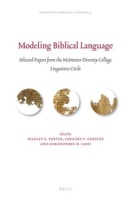 Modern linguistic theories have not been a popular interpretive tool in biblical studies up until perhaps recently. In fact, it is fair to say that many biblical scholars are still ignorant of them or at least hesitant to use them in studying the text of the Bible. There are a good number of reasons why this has been the case, and perhaps one of them could be the lack of linguistically-informed publications in biblical studies. Apart from the Brill-published Linguistic Biblical Studies (LBS) and a few academic journals such as Biblical and Ancient Greek Linguistics (BAGL) and Filología Neotestamentaria (FN), very few academic resources that utilize modern linguistic approaches to the study of the Bible are available in the field of biblical studies. While there may be some works that include linguistics or that purport to use some kinds of linguistic approaches to analyzing the biblical texts, I think that they cannot be considered as “linguistically informed” unless they demonstrate clear articulation and application of a linguistic theory. After reading the essays in Modeling Biblical Language: Selected Papers from the McMaster Divinity College Linguistics Circle, a recent publication by Brill in its LBS series, one might understand the linguistic rigor that it contains and the tone that it sets for linguistic biblical studies.
Modern linguistic theories have not been a popular interpretive tool in biblical studies up until perhaps recently. In fact, it is fair to say that many biblical scholars are still ignorant of them or at least hesitant to use them in studying the text of the Bible. There are a good number of reasons why this has been the case, and perhaps one of them could be the lack of linguistically-informed publications in biblical studies. Apart from the Brill-published Linguistic Biblical Studies (LBS) and a few academic journals such as Biblical and Ancient Greek Linguistics (BAGL) and Filología Neotestamentaria (FN), very few academic resources that utilize modern linguistic approaches to the study of the Bible are available in the field of biblical studies. While there may be some works that include linguistics or that purport to use some kinds of linguistic approaches to analyzing the biblical texts, I think that they cannot be considered as “linguistically informed” unless they demonstrate clear articulation and application of a linguistic theory. After reading the essays in Modeling Biblical Language: Selected Papers from the McMaster Divinity College Linguistics Circle, a recent publication by Brill in its LBS series, one might understand the linguistic rigor that it contains and the tone that it sets for linguistic biblical studies.
Modeling Biblical Language is a collection of papers on topics related to modern linguistics and biblical studies. This collection is a product of the efforts of its editors, Stanley Porter, Christopher Land, and Gregory Fewster, and especially of its contributors in collaboration with the McMaster Linguistics Circle. The contributors strongly believe that modern linguistic theories are heuristically and hermeneutically valuable for studying the biblical text. In the words of the book’s editors, “linguistics helps us to think about meaning and text, as well as about how human beings use language to make meaning with texts.” More specifically, most of the contributors find Systemic Functional Linguistics (SFL) useful for the aforesaid heuristic and hermeneutical task, while noting the diversity and continual development of thought among SFL practitioners (there are a few contributors who utilize other theories for their respective essays). It is the aim and desire of this volume that biblical scholarship will acknowledge and realize the significance of linguistically-informed studies of the Bible, and that it will continue to do so, so that biblical scholarship could reframe traditional questions as well as ask new questions different from those usually asked. Readers in general might find this volume a bit technical, but those interested in using a linguistic approach to study the Bible would find it a helpful and useful resource for learning how various linguistic theories are being applied to the biblical texts with specific exegetical aims and goals.
The volume is divided into three sections—modeling language, modeling the languages of the Hebrew Bible, and modeling the language of the New Testament. The opening essay reflects and comments upon the utility and implications of SFL as a methodological tool for study of ancient Greek, and the subsequent essays employ various linguistic theories (mostly indebted to SFL), such as evaluation theory, tagmemics, SFL register, metafunctional analysis, inter-clausal/clause complex analysis, lexical monosemy, intertextuality, staging and peaking analysis, and corpus linguistics to analyze various texts in the Hebrew Bible and the Greek New Testament, including Judges 6 and 13, Ezekiel 34, John 18:33-38, the book of Romans, Romans 9:30–10:13, 1 Corinthians 12–14, Ephesians and Colossians, James 2:1-13, and 1 Peter 1:3-12. Two essays discuss the linguistic construal of time in the Greek New Testament—Aspect and Aktionsart and relative temporal ordering. Contributors include Stanley E. Porter, Francis G.H. Pang, Jeffrey Reber, Mary L. Conway, Anthony Pyles, Beth M. Stovell, Christopher D. Land, Gregory P. Fewster, Xiaxia E. Xue, Hughson T. Ong, Zachary K. Dawson, and Benjamin B. Hunt. Together, these essays provide insights into what we may call linguistic approaches to analyzing the text of the Bible, and they also offer some glimpses into the kinds of scholarly work that is done at the Linguistics Circle.
— Hughson T. Ong

Hughson. another reason for the hesitancy of scholars to interact with these collections of papers might be the 135 Euro price tag!?
Peace
LikeLike
Thanks Bruce for the note. That is true to some extent, as Brill-published books are usually on the higher end in terms of pricing. However, libraries do carry these kinds of books as well. People who wish to interact could always get hold of a copy of the book. Cheers! Hughson.
LikeLike